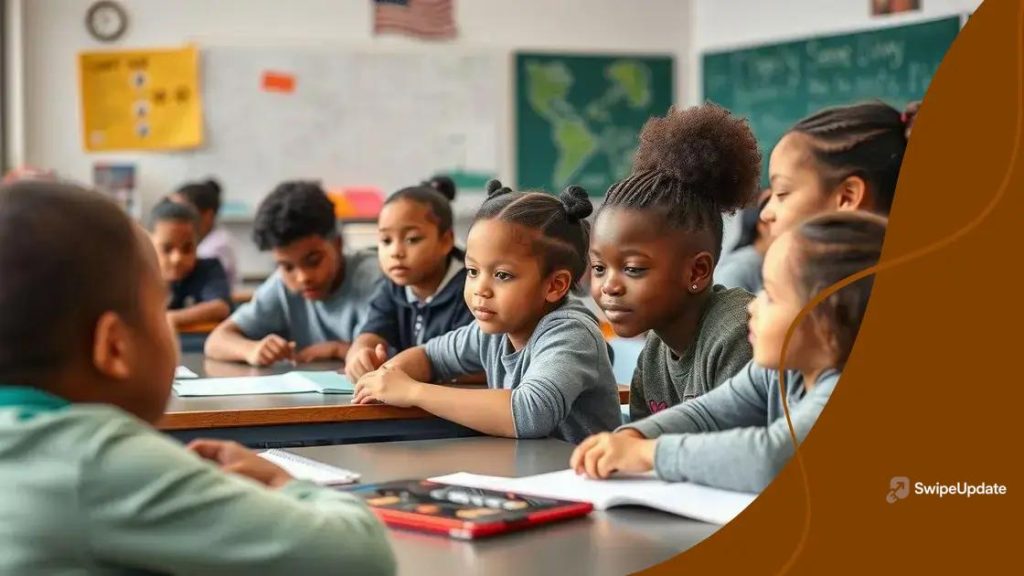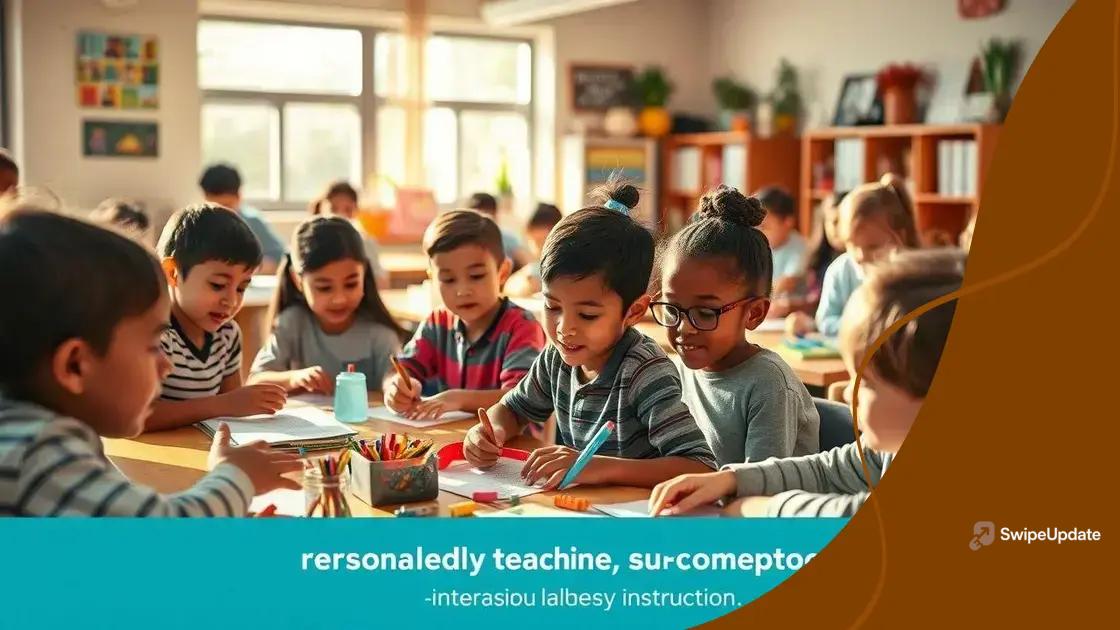Neurodiverse classrooms: fostering inclusivity and understanding

Neurodiverse classrooms create inclusive learning environments by engaging families and communities, using personalized teaching strategies, and providing tailored support to meet the unique needs of each student.
Neurodiverse classrooms represent a shift in how we think about education, embracing varied learning styles. Have you ever wondered how this impacts student engagement and success? Let’s delve into its significance.
Understanding neurodiversity in education
Understanding neurodiversity in education is vital for creating effective learning environments. It emphasizes the unique ways students think and learn. This perspective helps educators tailor their approaches to meet varied needs.
What is neurodiversity?
Neurodiversity refers to the natural variations in the human brain regarding cognition, learning, and behavior. Instead of viewing these differences as deficits, it’s crucial to recognize them as valuable variations. Each student has strengths and challenges that must be understood.
Benefits of embracing neurodiversity in classrooms
By acknowledging and embracing neurodiversity, teachers can create a richer learning experience. Some benefits include:
- Fostering inclusivity among students.
- Enhancing collaboration and social skills.
- Encouraging creativity and critical thinking.
- Improving academic outcomes for all learners.
When classrooms reflect diverse learning styles, students feel seen and valued. This connection boosts their confidence and engagement. Schools that champion neurodiversity often see a significant decrease in behavioral issues and an increase in positive interactions among students.
Understanding the spectrum of neurodiversity, which includes ADHD, autism, dyslexia, and more, allows educators to implement various approaches. Techniques such as differentiated instruction, flexible seating arrangements, and multimodal teaching methods cater to different learning preferences.
Ultimately, recognizing and supporting neurodiverse learners creates a foundation where all students can thrive. This approach not only benefits individual students but enriches the entire educational environment, making it a place of learning, growth, and understanding.
Creating an inclusive environment
Creating an inclusive environment in schools is essential for supporting all learners. An inclusive environment ensures that each student, regardless of their learning style or needs, feels welcomed and valued. This approach promotes mutual respect and understanding among students and staff.
Elements of an inclusive classroom
To foster an inclusive environment, certain key elements must be present:
- Welcoming physical space with accessible resources.
- Teaching methods that cater to various learning styles.
- Encouragement of collaboration and teamwork.
- Open communication among students and teachers.
Designing a classroom space that is both comfortable and functional helps set the tone. Consider arrangements that allow for group work and enable easy movement. Providing resources that are accessible to everyone also plays a vital role in ensuring that all students can engage fully.
Strategies for inclusion
Implementing specific strategies can greatly enhance inclusivity. These may include:
- Using assistive technology to aid learning.
- Incorporating group projects that leverage students’ strengths.
- Offering multiple ways for students to demonstrate learning.
Through these methods, students can connect with their peers and learn to appreciate diverse perspectives. Class discussions that honor different viewpoints promote respect and understanding. When students see their differences as strengths, the entire classroom experience improves.
Teachers should also provide regular feedback and support to create a safe space for all. This helps students feel comfortable sharing their thoughts and asking for help when needed. The ultimate goal is for each student to feel that they belong and can succeed, which is the heart of an inclusive environment.
Teaching strategies for neurodiverse classrooms

Teaching strategies for neurodiverse classrooms focus on meeting the unique needs of all students. These strategies help create engaging and supportive learning environments. By incorporating various methods, teachers can ensure that every learner is understood and valued.
Personalized learning approaches
One effective strategy is personalized learning. This method considers each student’s strengths and challenges. Teachers can tailor lessons, assignments, and assessments to fit individual needs. This adjusts the learning pace and style, making it more accessible.
Multisensory teaching techniques
Another important approach is the use of multisensory teaching techniques. These techniques engage multiple senses, helping students to understand concepts better. For example:
- Incorporating visuals like charts and diagrams.
- Using physical objects during lessons to clarify ideas.
- Integrating music or movement to reinforce learning.
When students are engaged through different senses, they can connect with the material in meaningful ways. This also makes learning more enjoyable and memorable.
Additionally, frequent check-ins can enhance understanding in neurodiverse classrooms. Teachers can ask questions, provide feedback, and adjust their teaching methods based on students’ responses. This ongoing dialogue helps build relationships and encourages students to express their needs.
Classroom management strategies are also essential. Establishing clear rules and routines creates a sense of structure. Using visuals for these rules can support students who struggle with traditional verbal instructions. Praise and positive reinforcement can motivate students and promote positive behavior.
Ultimately, applying a variety of teaching strategies in neurodiverse classrooms not only supports students with diverse needs but also enriches the entire learning experience. By focusing on inclusivity, teachers can foster a more harmonious and productive classroom environment.
Supporting neurodiverse students’ needs
Supporting neurodiverse students requires a tailored approach to address their unique needs. Each student’s cognitive process is different, and recognizing this helps create effective learning strategies. By implementing specific supports, educators can foster a more inclusive classroom.
Understanding individual needs
It is essential to understand that every neurodiverse student has unique strengths and challenges. Teachers can begin by observing students’ behaviors and learning styles. Gathering information from parents, caregivers, and previous educators can provide valuable insights into how to best support each student.
Utilizing accommodations
Implementing accommodations is crucial for supporting neurodiverse students. These may include:
- Providing extended time on tests and assignments.
- Offering quiet spaces for breaks during the school day.
- Using visual aids and hands-on materials to enhance understanding.
- Allowing for flexible seating arrangements to accommodate various learning styles.
Such accommodations can help students feel more comfortable within the classroom, allowing them to participate fully and reduce anxiety during instruction.
Creating structured routines is another way to support these learners. Consistent schedules help neurodiverse students know what to expect, which can ease transitions between activities. Visual schedules displayed in the classroom can help maintain this structure.
Additionally, fostering emotional support is key. Building strong relationships through trust and open communication encourages students to express their feelings. Teachers can check in regularly, providing a safe space for students to share concerns or ask for help. This layer of support promotes a positive classroom environment.
Ultimately, supporting neurodiverse students’ needs involves understanding, flexibility, and open dialogue. When educators adopt these strategies, they empower all learners to thrive, creating a richer educational experience that embraces diversity.
Engaging families and communities in education
Engaging families and communities in education is essential for the success of neurodiverse classrooms. Active participation from families builds a strong support system for students. It also reinforces the connection between home and school, making learning more effective.
Building partnerships with families
Teachers can create successful partnerships with families by maintaining open communication. Regular updates about classroom activities, student progress, and upcoming events help keep parents informed. Tools like newsletters, emails, and parent-teacher meetings are effective ways to share this information.
Involving the community
Involving the community enhances the educational experience for neurodiverse students. Schools can collaborate with local organizations to provide resources and support. Possible partnerships include:
- Inviting local experts to speak in classrooms.
- Organizing community workshops for parents.
- Creating volunteer programs that allow community members to assist in schools.
These connections enrich student learning and show that education extends beyond the classroom. When community members support schools, students feel more connected to their surroundings.
Events such as family nights, cultural celebrations, and workshops can also foster strong relationships between schools and families. These gatherings promote understanding and allow families to share their experiences and insights. This creates a welcoming atmosphere where parents feel valued.
Furthermore, schools should recognize the diversity within families. Offering resources in multiple languages, flexible meeting times, and cultural celebrations makes it easier for all families to participate. Empowering parents to share their unique perspectives enhances the learning environment for every student.
Ultimately, engaging families and communities fosters an enriched educational experience. When everyone works together, neurodiverse students can thrive, and schools benefit from diverse ideas and resources.
FAQ – Frequently Asked Questions about Neurodiverse Classrooms
How can families engage with schools to support neurodiverse students?
Families can engage by attending meetings, volunteering, and maintaining open communication with teachers about their children’s needs.
What are some effective strategies for creating an inclusive environment?
Effective strategies include using visual aids, providing accommodations, and fostering collaboration among students.
How can community involvement benefit neurodiverse classrooms?
Community involvement provides additional resources, expert insights, and a broader support network for students and families.
What role does personalized learning play in neurodiverse education?
Personalized learning tailors educational experiences to individual needs, strengths, and challenges, promoting better engagement and understanding among neurodiverse students.
